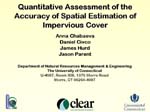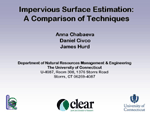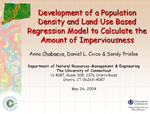| Papers |
Chabaeva, A.A., J. Hurd, and D.L. Civco. 2007. Quantitative Assessement of the Accuracy of Spatial Estimation of Impervious Cover.Proc. 2007 ASPRS Annual Convention, Tampa, FL 11 p. |
Civco, D.L., A.A. Chabaeva and J. Hurd. 2006. A Comparison of Approaches to Impervious Surface Characterization. Proc. 2006 IGARSS Convention, Denver, CO 5 p. |
Chabaeva, A.A., D.L. Civco and S. Prisloe. 2004. Development of a Population Density and Land Use Based Regression Model to Calculate the Amount of Imperviousness. Proc. 2004 ASPRS Annual Convention, Denver, CO 9 p. |
| Presentations | |
 |
Estimation Tool for Impervious Surfaces (ETIS) - This presentation describes functionality of newly developed ETIS tool. This tool allows calculating the amount of imperviousness for specified area based on land cover and population density data. It was developed using linear regression equation and a set of coefficients based on the classes of the land cover map used. There are several sets of coefficients included with the Toolbox for Connecticut Land Cover (CCL) 2002 and National Land Cover Data (NLCD) 2001, but ETIS also allows to import custom sets and to demonstrate the effect of change in land cover on the amount of imperviousness. NEARC 2008. 1.9 Mb |
 |
Quantitative Assessment of the Accuracy of Spatial Estimation of Impervious Cover - This project reports on several approaches to estimating percent imperviousness and is part of ongoing research aimed at developing a suite of analysis tools for effective land management. ASPRS 2007. 4.5 Mb |
 |
Impervious Surface Estimation: A Comparison of Techniques - This project reports on several approaches to estimating percent imperviousnessand compares impervious surface estimates derived from modeling approaches such as Subpixel Classification, Impervious Surface Analysis Tool (ISAT) and Population Density and Land Use-based Regression model. NEARC 2006. 3.5 Mb |
 |
Development of a Population Density and Land Use Based Regression Model to Calculate the Amount of Imperviousness - Developing, assessing and refining the regression-based modeling technique to be used with National Land Cover Data (NLCD) and population density to predict percent imperviousness. Interpolating population density value for Connecticut watersheds and estimating percent imperviousness for CT Census tracts and watersheds. ASPRS 2004. 8.1 Mb |
| Posters | |
| A Comparison of Approaches to Impervious Surface Characterization - this color poster measures 40" by 48" and compares the results of various methods for the estimation of impervious surfaces. The poster was displayed at IGRASS 2006 (International Geoscience And Remote Sensing Symposium) held July 31 - August 4, 2006, Denver, CO. Download related paper. | |